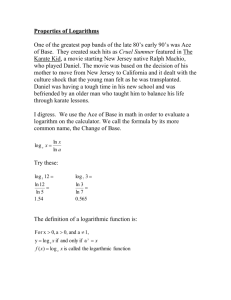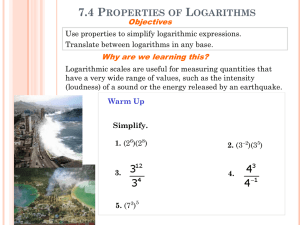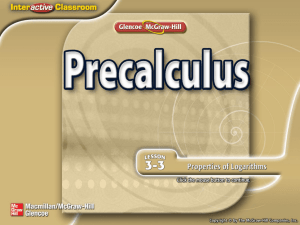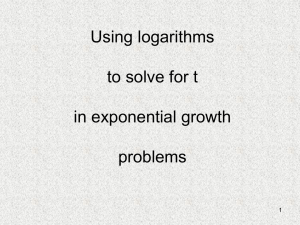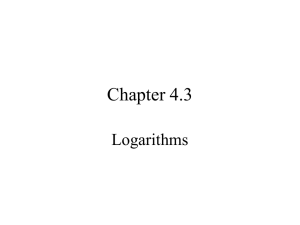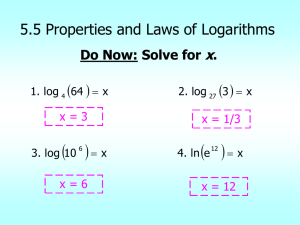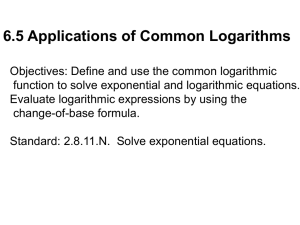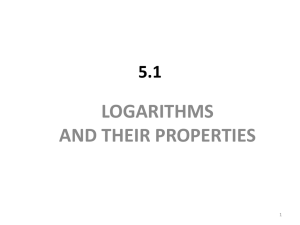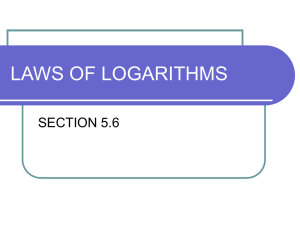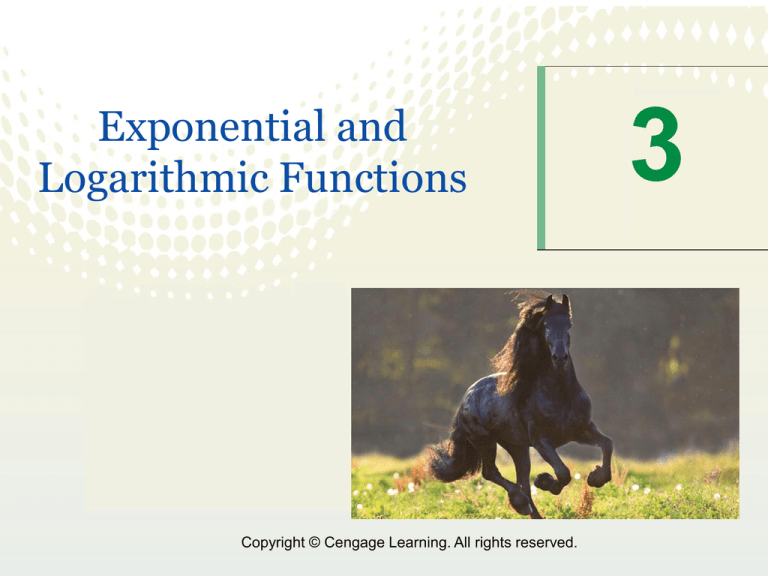
Exponential and
Logarithmic Functions
Copyright © Cengage Learning. All rights reserved.
3
3.3
PROPERTIES OF LOGARITHMS
Copyright © Cengage Learning. All rights reserved.
What You Should Learn
• Use the change-of-base formula to rewrite and
evaluate logarithmic expressions.
• Use properties of logarithms to evaluate or
rewrite logarithmic expressions.
• Use properties of logarithms to expand or
condense logarithmic expressions.
• Use logarithmic functions to model and solve
real-life problems.
3
Change of Base
4
Change of Base
Most calculators have only two types of log keys, one for
common logarithms (base 10) and one for natural
logarithms (base e).
Although common logarithms and natural logarithms are
the most frequently used, you may occasionally need to
evaluate logarithms with other bases. To do this, you can
use the following change-of-base formula.
5
Change of Base
One way to look at the change-of-base formula is that
logarithms with base a are simply constant multiples of
logarithms with base b. The constant multiplier is (1/logb a).
6
Example 1 – Changing Bases Using Common Logarithms
a.
Use a calculator.
Simplify.
b.
7
Properties of Logarithms
8
Properties of Logarithms
We know that the logarithmic function with base a is the
inverse function of the exponential function with base a.
So, it makes sense that the properties of exponents should
have corresponding properties involving logarithms.
For instance, the exponential property a0 = 1 has the
corresponding logarithmic property loga 1 = 0.
9
Properties of Logarithms
10
Example 3 – Using Properties of Logarithms
Write each logarithm in terms of ln 2 and ln 3.
a. ln 6
b. ln
Solution:
a. ln 6 = ln (2 3)
= ln 2 + ln 3
b. ln
= ln 2 – ln 27
= ln 2 – ln 33
= ln 2 – 3 ln 3
Rewrite 6 as 2 3.
Product Property
Quotient Property
Rewrite 27 as 33.
Power Property
11
Rewriting Logarithmic Expressions
12
Rewriting Logarithmic Expressions
The properties of logarithms are useful for rewriting
logarithmic expressions in forms that simplify the
operations of algebra.
This is true because these properties convert complicated
products, quotients, and exponential forms into simpler
sums, differences, and products, respectively.
13
Example 5 – Expanding Logarithmic Expressions
Expand each logarithmic expression.
a. log4 5x3y
b.
Solution:
a. log4 5x3y = log4 5 + log4 x3 + log4 y
= log4 5 + 3 log4 x + log4 y
Product Property
Power Property
14
Example 5 – Solution
b.
cont’d
Rewrite using rational
exponent.
Quotient Property
Power Property
15
Application
16
Application
One method of determining how the x- and y-values for a
set of nonlinear data are related is to take the natural
logarithm of each of the x- and y-values.
If the points are graphed and fall on a line, then you can
determine that the x- and y-values are related by the
equation
ln y = m ln x
where m is the slope of the line.
17
Example 7 – Finding a Mathematical Model
The table shows the mean distance from the sun x and the
period y (the time it takes a planet to orbit the sun) for each
of the six planets that are closest to the sun. In the table,
the mean distance is given in terms of astronomical units
(where Earth’s mean distance is defined as 1.0), and the
period is given in years. Find an equation that relates
y and x.
18
Example 7 – Solution
The points in the table above are
plotted in Figure 3.26. From this
figure it is not clear how to find an
equation that relates y and x.
To solve this problem, take the
natural logarithm of each of the
x- and y-values in the table. This
produces the following results.
Planets Near the Sun
Figure 3.26
19
Example 7 – Solution
cont’d
Now, by plotting the points in the
second table, you can see that
all six of the points appear to lie
in a line (see Figure 3.27). Choose
any two points to determine
the slope of the line.
Using the two points (0.421, 0.632)
and (0, 0), you can determine
that the slope of the line is
Figure 3.27
20
Example 7 – Solution
cont’d
By the point-slope form, the equation of the line is Y = X
where Y = ln y and X = ln x.
You can therefore conclude that ln y = ln x.
21

